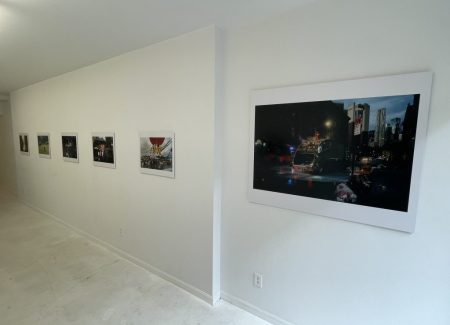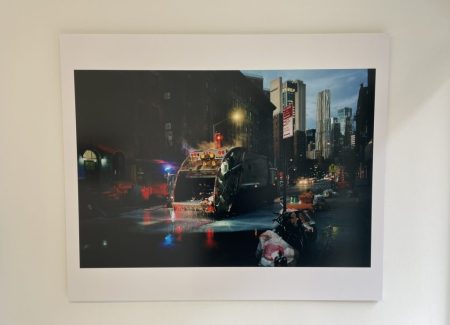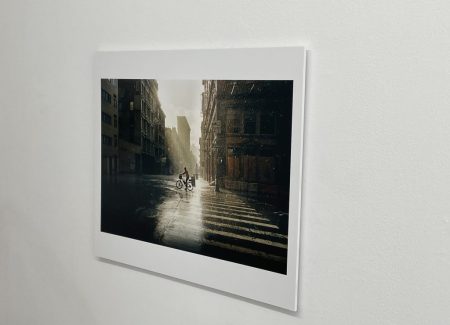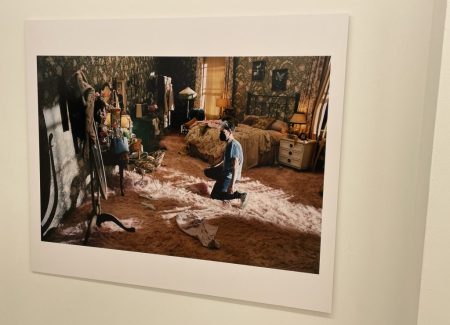JTF (just the facts): A total of 22 color photographs, mounted and unframed, and hung against white walls in the two room gallery space. All of the works are chromogenic prints, made in the past few years and printed in 2022. Physical sizes are either 40×50 inches (in editions of 2+2AP) or 20×24 inches (in editions of 5+2AP); there are 3 large works and 19 small works on view in the show. (Installation shots below.)
Comments/Context: We’ve reached a 21st century moment where the portability of photography has become so fluid and unencumbered that the friction between presentation mediums is becoming almost an afterthought. Images that we make are now jumping from platform to platform and from physical manifestation to digital incarnation and back again with such ease and rapidity that it’s hard to keep up with the transformations; in fact, we might be slowly becoming numb to the very real differences that exist between an image on a phone screen and a print on a wall.
This in-many-places-at-once reality recently hit home for me when I visited Daniel Arnold’s recent show at Larrie. Arnold first made his photographic presence known via his Instagram feed (here) several years ago now, where his street photographs have offered a brash update on the basic premise of decisive moment urban observation. His excellent 2021 photobook Pickpocket (reviewed here) then took many of these same photographs and placed them in a wholly different context – inside the inventive design of a cinematic photobook, with extended (and often introspective) captions. The photographic shape shifting continued with a handful of enlarged prints shown in a tightly cramped booth at the NADA New York art fair this past May, and has now taken form as a full-fledged gallery show, with exhibition prints filling a white-walled gallery space in the Lower East Side. A few of the images have appeared in all four “venues”, seemingly slipping through rips in the space time continuum to appear in each new instance of reality.
While the idiosyncratic juxtapositions and unexpected moments of street photography, particularly the brand perfected in New York city in the 20th century, have long been celebrated, in many ways, as we transition to the complexities of the digital present, if street photography isn’t exactly out of favor, it is at least less central to the photographic conversation than it once was. This then places Arnold in the tricky position of not only trying to find (and refine) his own voice as a contemporary photographer, but also attempting to breathe some freshness into the genre, or at least find ways to make its strengths more relevant once again.
The winnowing down from hundreds of images on an Instagram feed or in a photobook to a dozen or two in a gallery show is of course an intense process of selection and editing, and Arnold might have chosen any number of slices of work to pull out of the larger flow of his artistic activity from the past half dozen years. What he has selected isn’t a set of lucky chance shots or serendipitous street comedies, nor it is particularly centered on the unlikely juxtapositions of unusual people to be found on city sidewalks, which is often the bread and butter of street photography. Instead, most of Arnold’s photographs in this gallery show are ambiguous single frame situations, the kind that might inspire a short story with an unexpected ending.
The action taking place in these pictures, if there is any, is generally subtle or introspective. One man sniffs a flower in his car, lost in thought, with an effervescent bouquet tucked in his backseat. Another wearing a tuxedo, perhaps a Little Italy restaurant tout, closes his eyes for a quick moment of weary peace while standing with an umbrella in the rain. A third man, with a broken nose and an arm in a cast, seems to ponder his solitary fate at a sidewalk restaurant. Yet another man simply stares dumbfounded at the barbecued duck hanging in a Chinese restaurant window. And the most agitated man of the group looks out from his car with hollow eyes and a bloody nose, perhaps just after an accident. Each seems at a point of making a choice, or assessing the meaning of recent events that have taken place off camera.
When more than one person is part of Arnold’s scenes, the interplay of action and reaction becomes more prominent, offering even more openings for potential narratives. High school cheerleaders with bows in their hair sit around a lunch table looking at their phones, while a lone girl watches from a nearby seat. A boy scout slumps over on a rising carnival ride, while his wide eyed younger companion takes in the elevated view. Two long haired blonde women sitting in a theater turn around to talk with a group of policemen in the row behind, with one cop asleep in the seat next to them. And a woman takes a selfie on a ferry surrounded by shiny empty chairs, performing for her own camera as well as indirectly for Arnold’s. Each scene could have any number of possible interpretations, allowing the viewer to construct his or her own story from the available evidence.
As Arnold moves inside, his images become more controlled, almost as if a whiff of staging has entered the picture. In one image, a wet-haired woman in a towel sits on a couch flanked by a golden Buddha that provides an echo of her bent arms and legs, with her red towel and the wall behind in matching hues. In another, a man in a Covid-era mask and plastic face screen kneels in a cluttered bedroom with eye-catching pink shag carpeting, seemingly looking at himself in a mirror. In both perplexing moments, there is just enough going on to open up our pathways of imagination.
Even when there are no people in Arnold’s pictures, he can make the city itself take on nuances of emotion. A garbage truck slithering through an up-to-its-wheels puddle in the early morning takes on a grandly dystopian vibe, with disgusting water dripping from its open maw and colored lights enveloping it in seething glare. A downpour drenching an outdoor dining area is much less forbidding, the yellow wood tables and a passing bus creating some color harmonies and the glassware on the table alluding to a meal interrupted with haste. And a flower shadow cast across the table in a diner has an almost romantic mood, the quiet moment of grace interspersed with sharp compositional angles and pops of color.
What Arnold’s strongest pictures seem to be offering is a less deterministic and more open-ended view of the city – what we see happening isn’t entirely clear, and Arnold isn’t framing it in a way that makes his point of view explicit. And while another edit of Arnold’s work might have featured a more bold and confrontational flash-lit vibe, the narrative ambiguity he has chosen to show us is a more nuanced and indirect way of defining singular urban moments. Instead of a street photography that tells us what to think of a given scene, Arnold has successfully crafted an approach that feels more deliberately elusive. It seems to say that the city is never quite what it seems, and that’s exactly why it’s worth looking at again and again.
Collector’s POV: The prints in this show are priced at $3000 and $6000, based on size. Arnold’s work has little secondary market history at this point, so gallery retail remains the best option for those collectors interested in following up.





















Thank you for showing us great insight into our lives!
Beautiful work !
Maria Cox